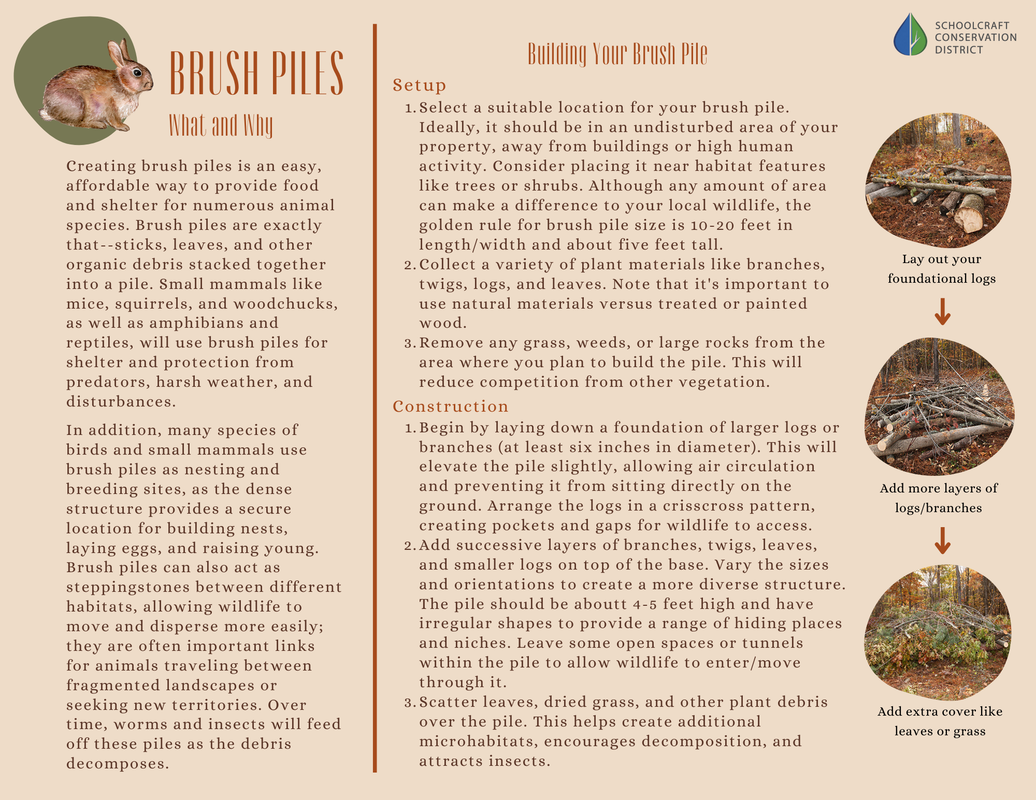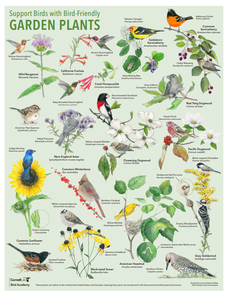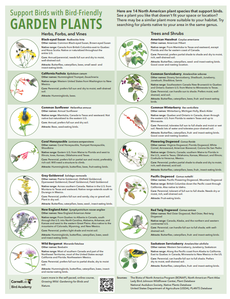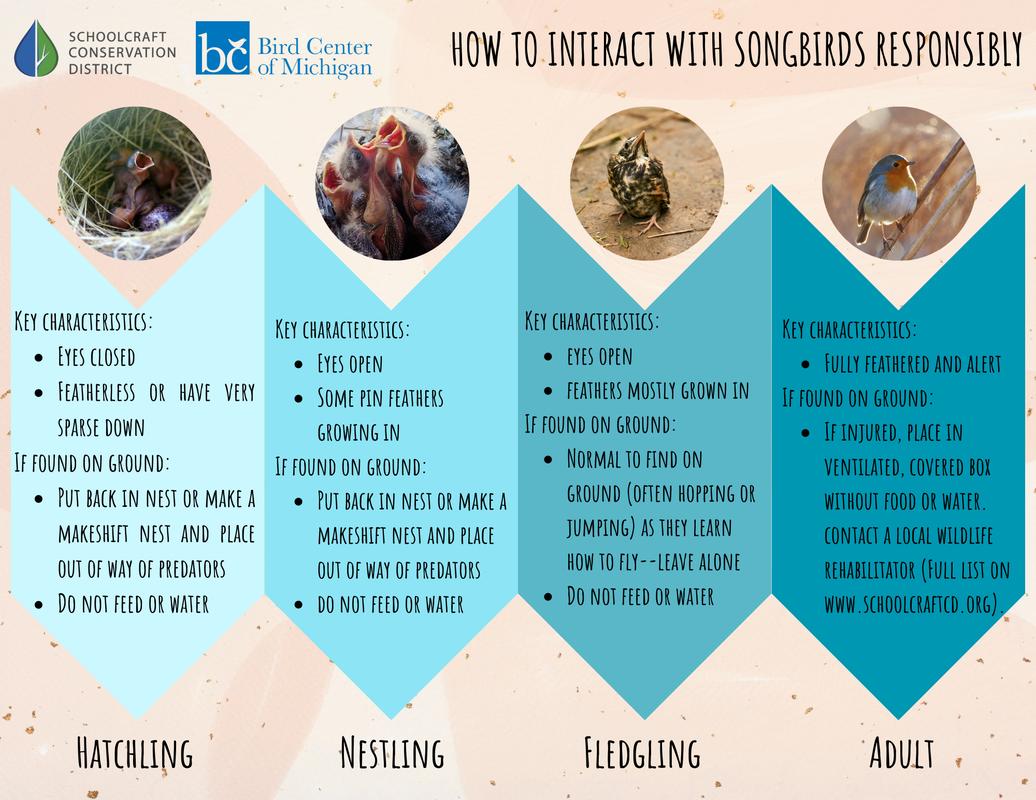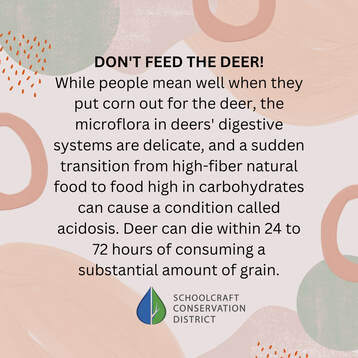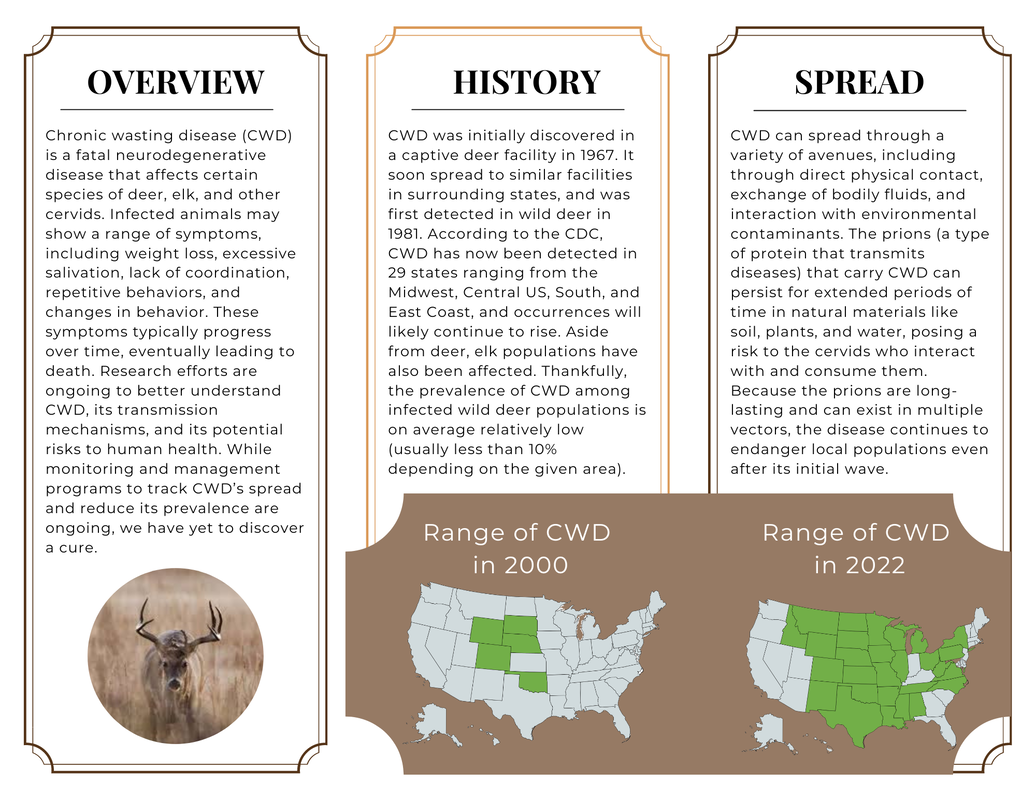Wildlife Habitats
|
Michigan has an incredible variety of ecosystems, including forests, wetlands, grasslands, and freshwater bodies--many of which can be found within the boundaries of a single property. Because of this richness in our landscapes, Michigan is also home to a diverse range of species, each of which has a unique set of needs. Building a successful wildlife habitat will mean different things for different species, but common considerations will include what types of plants or trees a given animal favors, food sources, water sources, habitat layers (i.e., ground cover, shrubs, and canopy), nesting sites, and connectivity.
Michigan's Department of Natural Resources offers a wealth of information on how to use these different elements to attract various wildlife; we encourage anyone interested in learning more to refer to their species guides. The SCD and our partner organizations also offer free technical assistance, free site visits, and cost-share programs to Schoolcraft County residents. Contact our office to learn more about how we can help you manage your resources to build a sustainable habitat that will support our local wildlife for years to come. |
Distressed Wildlife
When seeing wildlife they think are in distress, most people want to help but aren't necessarily sure how to. It doesn't help matters that there's a lot of misinformation surrounding this topic.
Before taking any further steps, assess the situation and make sure the animal needs help. In many species, a parent or parents will leave their babies alone for long periods at a time, and the babies can easily be mistaken for abandoned. Even orphaned animals don't necessarily require assistance. Unless an animal is obviously injured, keep your distance and observe for several hours before interfering.
Always be cautious when handling wild animals, even if they're young or look otherwise harmless. They are unpredictable, especially when hurt or stressed, and can easily injure either a person or themselves. It's also important to be aware of possible diseases they may be carrying. Wear gloves whenever possible before touching an animal, and never approach an animal showing signs of a disease (e.g., salivating, stumbling, glazed eyes).
When in doubt, contact your local police department or a licensed wildlife rehabilitator. A list of licensed rehabilitators in the UP can be found below.
Deer
Does often leave their fawns alone for hours at a time as they go off to feed, and when coming across a fawn that's lying still and curled up into a ball (a very normal behavior for young fawns), it's easy to assume they need help when they don't. If you do come across a fawn in this situation, quietly leave the area without touching it. If the fawn has been consistently crying out for several hours or has curling ear tips (a sign of dehydration), contact one of the wildlife rehabilitators specializing in deer as listed below.
Birds
Contrary to the popular myth that you shouldn't touch a baby bird since its parents will smell your scent and abandon it, birds actually have a very poor sense of smell. If you notice a mostly featherless baby bird that's fallen out of a nest, you can gently pick it up and put it back. If the nest is too high to reach, move the bird as close as possible to it. If the bird is a fledgling (slightly larger, has feathers, is moving around), it's likely learning how to fly and should be left alone.
Before taking any further steps, assess the situation and make sure the animal needs help. In many species, a parent or parents will leave their babies alone for long periods at a time, and the babies can easily be mistaken for abandoned. Even orphaned animals don't necessarily require assistance. Unless an animal is obviously injured, keep your distance and observe for several hours before interfering.
Always be cautious when handling wild animals, even if they're young or look otherwise harmless. They are unpredictable, especially when hurt or stressed, and can easily injure either a person or themselves. It's also important to be aware of possible diseases they may be carrying. Wear gloves whenever possible before touching an animal, and never approach an animal showing signs of a disease (e.g., salivating, stumbling, glazed eyes).
When in doubt, contact your local police department or a licensed wildlife rehabilitator. A list of licensed rehabilitators in the UP can be found below.
Deer
Does often leave their fawns alone for hours at a time as they go off to feed, and when coming across a fawn that's lying still and curled up into a ball (a very normal behavior for young fawns), it's easy to assume they need help when they don't. If you do come across a fawn in this situation, quietly leave the area without touching it. If the fawn has been consistently crying out for several hours or has curling ear tips (a sign of dehydration), contact one of the wildlife rehabilitators specializing in deer as listed below.
Birds
Contrary to the popular myth that you shouldn't touch a baby bird since its parents will smell your scent and abandon it, birds actually have a very poor sense of smell. If you notice a mostly featherless baby bird that's fallen out of a nest, you can gently pick it up and put it back. If the nest is too high to reach, move the bird as close as possible to it. If the bird is a fledgling (slightly larger, has feathers, is moving around), it's likely learning how to fly and should be left alone.
|
If you find an injured adult bird on the ground, keep your pets inside as you work with it, no matter how well-trained they are. Place it in a closed box with some cushioning, such as a shredded paper or bunched up Kleenex, and resist giving it any food or water. The box should have some ventilation to ensure adequate airflow but the bird shouldn't be able to see out of it. A shoebox with holes punctured into it works well for this if you have one on hand.
After securing the bird, contact one of the bird rehabilitators below or call the Bird Center of Michigan at 734-761-9640 to determine next steps. |
Bats
Because bats have an elevated chance of carrying rabies, it's highly recommended to avoid touching them. However, unlike birds, bats aren't able to take flight off the ground, so if you find one on the ground outside, you can help it by moving it to an elevated height. Gently prod at its feet with a two-to-three-foot stick or similar rod; the bat will likely reflexively grab on. With slow movements, place it in a tree, ideally in a concealed spot that offers some cover from predators.
If a bat gets into your home, close all interior doors and open your windows, as there's a good chance it will fly out on its own. If not, put on thick gloves and a thick jacket (non-cotton, as bats can bite through cotton). Fine a container and piece of cardboard. When the bat lands, slowly place the container over it with the cardboard piece acting as a temporary cover. From there, you can move it outside.
Again, due to their higher chance of carrying rabies, call a rehabilitator immediately upon finding an injured bat. Keep pets away from it, but don't attempt to handle it on your own without further guidance.
Because bats have an elevated chance of carrying rabies, it's highly recommended to avoid touching them. However, unlike birds, bats aren't able to take flight off the ground, so if you find one on the ground outside, you can help it by moving it to an elevated height. Gently prod at its feet with a two-to-three-foot stick or similar rod; the bat will likely reflexively grab on. With slow movements, place it in a tree, ideally in a concealed spot that offers some cover from predators.
If a bat gets into your home, close all interior doors and open your windows, as there's a good chance it will fly out on its own. If not, put on thick gloves and a thick jacket (non-cotton, as bats can bite through cotton). Fine a container and piece of cardboard. When the bat lands, slowly place the container over it with the cardboard piece acting as a temporary cover. From there, you can move it outside.
Again, due to their higher chance of carrying rabies, call a rehabilitator immediately upon finding an injured bat. Keep pets away from it, but don't attempt to handle it on your own without further guidance.
Rehabilitator |
Location |
Contact |
Animals |
Kristina Korntved |
Wallace, Menominee County |
(715) 923-3175 |
Deer, fawns |
Kyann Clarke |
Marquette, Marquette County |
(406) 552-5680 |
Small mammals, fawns |
Gloria Urban |
Skandia, Marquette County |
(906) 361-3140 |
Mammals only; does not take fawns or rabbits |
Jerome Maynard |
Marquette, Marquette County |
(906) 249-3598 |
Raptors, migratory birds |
Lois Bonno |
Iron River, Iron County |
(906) 265-4739 |
Birds, small mammals; does not take fawns or raccoons |
Michelle Anderson |
Hancock, Houghton County |
(906) 299-2149 |
Migratory birds; does not take raptors |
Jennifer Burroughs |
Lake Linden, Houghton County |
(906) 369-2027 |
Small mammals, non-migratory birds |
Beth Maatta |
Hancock, Houghton County |
(906) 370-3825 |
Small mammals, migratory birds |
A full list of licensed Michigan rehabilitators is available through the DNR: Michigan Licensed Rehabilitators (michigandnr.com).
Feeding Wildlife
Well-meaning people often set food out for wildlife with the intention of helping their local critters, but they unfortunately can end up doing a lot of harm in the process. It's also worth noting that many places--public and private alike--have rules or laws in place prohibiting or regulating the feeding of wildlife. For this reason, it's important to stay informed about what is and isn't safe--and legal--to provide.
Ducks and Waterfowl
While it's a common sight in parks and ponds to see people feeding bread to ducks and other waterfowl, it's actually not a good practice and can be harmful to the ducks and their environment. For one, bread is not a natural food for ducks and lacks the essential nutrients they need for a balanced diet. Feeding them large amounts of bread can lead to malnutrition, which can weaken their immune systems and make them more susceptible to diseases. Ducks also have a natural instinct to eat whenever food is available. Bread is high in carbohydrates, and when ducks consume large quantities of it, they can become overweight or even obese. Obesity can lead to health issues and reduce their ability to fly and escape from predators.
In addition, feeding ducks and other waterfowl habituates them to human interaction and handouts. This can lead to a dependency on humans for food, disrupting their natural foraging behaviors. Wild ducks should rely on their natural instincts to find food in their environment. And, when ducks are fed by people, they can become more aggressive in their pursuit of food. This can lead to issues for both other ducks and humans, creating an unpleasant experience for everyone involved.
Aside from harm to birds uneaten bread in the water can lead to water pollution, as it contributes to an excess of nutrients in the water, which can lead to algal blooms. Algae consume oxygen in the water, leading to low oxygen levels that can harm aquatic life, including fish and other creatures living in the same environment.
Instead of feeding waterfowl bread, consider providing them with healthier and more appropriate food options such as:
Deer
Feeding deer, like feeding ducks, can have negative consequences for both the deer and environment. Same as with ducks and other waterfowl, when deer become accustomed to being fed by humans, they can become dependent on this artificial food source, leading to disruptions in their natural foraging behaviors and decreased survival skills in the wild.
Ducks and Waterfowl
While it's a common sight in parks and ponds to see people feeding bread to ducks and other waterfowl, it's actually not a good practice and can be harmful to the ducks and their environment. For one, bread is not a natural food for ducks and lacks the essential nutrients they need for a balanced diet. Feeding them large amounts of bread can lead to malnutrition, which can weaken their immune systems and make them more susceptible to diseases. Ducks also have a natural instinct to eat whenever food is available. Bread is high in carbohydrates, and when ducks consume large quantities of it, they can become overweight or even obese. Obesity can lead to health issues and reduce their ability to fly and escape from predators.
In addition, feeding ducks and other waterfowl habituates them to human interaction and handouts. This can lead to a dependency on humans for food, disrupting their natural foraging behaviors. Wild ducks should rely on their natural instincts to find food in their environment. And, when ducks are fed by people, they can become more aggressive in their pursuit of food. This can lead to issues for both other ducks and humans, creating an unpleasant experience for everyone involved.
Aside from harm to birds uneaten bread in the water can lead to water pollution, as it contributes to an excess of nutrients in the water, which can lead to algal blooms. Algae consume oxygen in the water, leading to low oxygen levels that can harm aquatic life, including fish and other creatures living in the same environment.
Instead of feeding waterfowl bread, consider providing them with healthier and more appropriate food options such as:
- Duck feed or waterfowl pellets available at pet stores.
- Fresh fruits and vegetables like lettuce, spinach, peas, corn, and grapes (cut into small pieces).
- Duck-friendly birdseed or cracked corn.
Deer
Feeding deer, like feeding ducks, can have negative consequences for both the deer and environment. Same as with ducks and other waterfowl, when deer become accustomed to being fed by humans, they can become dependent on this artificial food source, leading to disruptions in their natural foraging behaviors and decreased survival skills in the wild.
|
However, dependency on humans is one of the lesser concerns when it comes to feeding deer. Deer have specialized stomachs that allow them to digest their natural diet effectively. Sudden changes in diet, such as consuming large amounts of corn, can disrupt their digestive system and lead to issues like colic and other gastrointestinal problems. Corn, one of the staple handouts among deer enthusiasts, also lacks the fibrous content deer need for proper digestion, which can cause constipation and impact their overall digestive health. In the worst-case scenario, switching from a high fiber diet to a diet high in carbs can lead to acidosis, a condition that can be fatal.
|
The transmission of diseases like Chronic Wasting Disease (CWD) is another major concern. CWD is a fatal neurodegenerative disease that affects certain species of deer, elk, reindeer, and moose, characterized by a long incubation period of neurological degeneration before ultimately ending in the death of the infected animal. Unfortunately, when deer gather around a concentrated food source, the risk of disease transmission skyrockets, leading to the spread of CWD and other similar infections.
If you enjoy watching deer, it's best to do so from a distance. Instead of providing food, try to support wildlife conservation efforts and preserve natural habitats to ensure the well-being of deer and other native species.
If you enjoy watching deer, it's best to do so from a distance. Instead of providing food, try to support wildlife conservation efforts and preserve natural habitats to ensure the well-being of deer and other native species.
